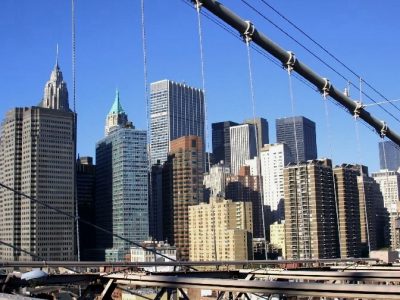
https://ukadventureracing.co.uk/members/kennym/activity/1510/ Skyline from Brooklyn Bridge
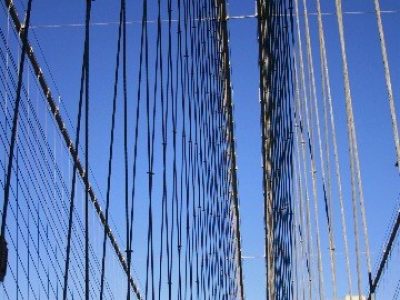
Brooklyn Bridge pier silhouette
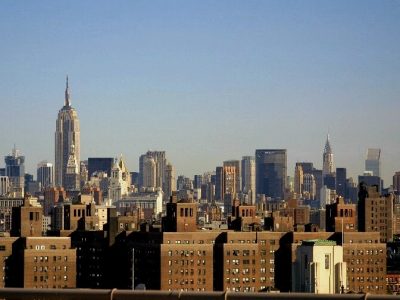
Skyline, Empire State & Chrysler
Friday, October 19, 2001; 4:49AM
Yesterday, I was out in the early morning sun and down by subway to the area near City Hall. I walked in the direction of the (former) World Trade Center and found, not unexpectedly, that my access was blocked from maybe 4 blocks out . . . I saw the big dump trucks and public service vehicles, which were permitted to go through.
The area was permeated with a bit of an acrid, burning smell. Smoke seemed to be rising out of sewer manholes (one even had a makeshift ‘chimney’ over the opening). Looking down the street toward the Center, I could see some smokiness in the air . . . visibility in the area seemed reduced, hazy. Still, the smell was not all that strong . . . it reminded me of smelling the ashes of a trash fire that’s burned out.
I felt a little guilty being down there, nosing around. Was I satisfying a morbid interest? Was I somehow ‘getting in the way’? With this (especially at first), I made an effort to remember the events of September 11 and how I felt at the time, feeling a reverence for the site.
Next, I walked over the Brooklyn Bridge, taking my time & lots of pictures. I was able to recall something about the human costs, challenges, and pride of building the bridge and was able to tie in, just a bit, thoughts of the dynamic city around me, which man had made.

Cables on blue

Cables on blue (close-up)
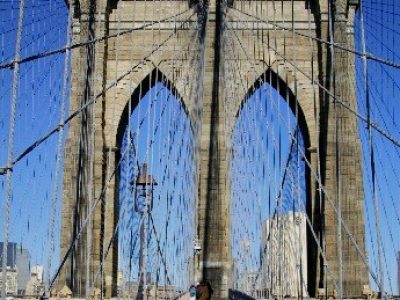
Pier against sky
Early afternoon found me in Bryant Park (just behind the NYC main public library). Later in the day, I found myself down near the Empire State Building and thought I’d check it out. It was something I’d wanted to do (to go up to the observation deck), however it was only 5PM, with sunset an hour & a half away. Since I was there, I went right then, thinking I could stay until dark. Later it came to be dusk, with buildings detailed and enchanting, the way they will be in a great high-rise city after dark . . . there was beauty to be seen & pictures to be taken, and I found myself singing (quietly to myself) “New York, New York.”
Next, I walked over the Brooklyn Bridge, taking my time & lots of pictures. I was able to recall something about the human costs, challenges, and pride of building the bridge and was able to tie in, just a bit, thoughts of the dynamic city around me, which man had made.
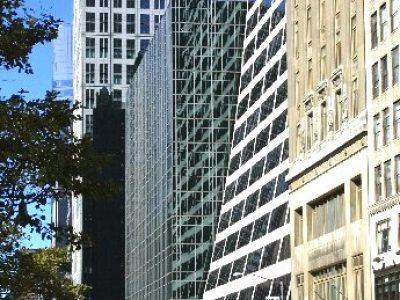
Across from Bryant Park

Bryant Park
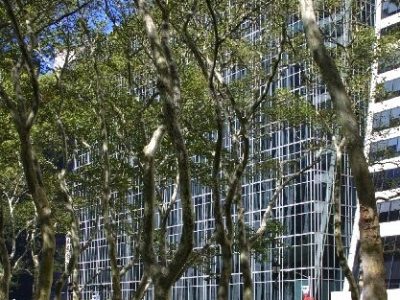
Bryant Park

Bryant Park on lunch hour
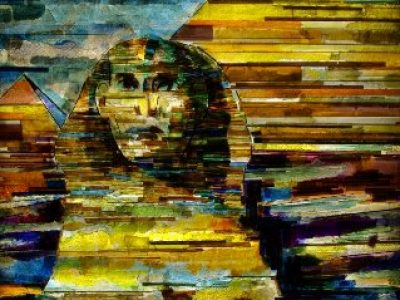
Stained glass, lobby Empire State
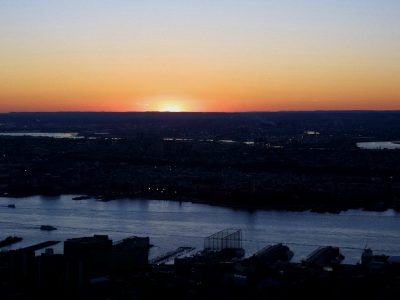
Hudson at sunset from ES
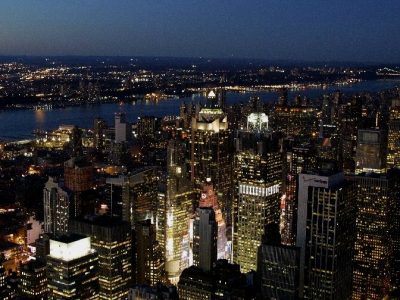
From ES looking NW at dusk

From ES looking south
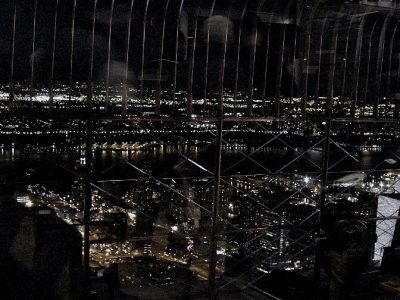
From ES, looking west through glass
By the way, my subway trip downtown from Central Park West was a special experience when I got down toward approaching City Hall. There were multiple tracks on multiple levels with multiple trains, all over a period of less than a minute or so. Adjacent tracks would upgrade or downgrade to a higher or lower level (in relation to the track we were traveling) and sometimes another train was there, traveling in the same direction as us, at nearly the same speed, rising to a higher level or falling to lower level, people clearly visible in cars across the way, lit up in their cocoons in the otherwise darkish underground.
Saturday, October 20, 2001; 5:12AM
Yesterday (Friday) I had good times at The Cloisters and at the Hayden Planetarium & Rose Center of the American Museum of Natural History. I was into the things I saw there and into taking pictures at those places. I was into flow.
First, The Cloisters, an adjunct of the Metropolitan Museum of Art ($10 recommended admission) located in the far northwestern part of Manhattan in, near, or part of Fort Tryon Park (and the A-train’s 190th Street station). The Cloisters are dedicated to medieval art. Physically, it’s a single building of stone & pleasing proportion, incorporating disparate parts, including two more or less complete cloisters taken from medieval monasteries, abbeys, or the like.
A cloister is like the courtyard of a monastery, essentially a completely enclosed garden, open to the sky but apart from the world outside the monastery. It’s open-aired, but covered, with a walkway around the perimeter of heavy stone and tile roofing supported by stone pillars. It’s a secluded garden setting that might be suitable for contemplation, which may be just was some of the monks would do there. In this case, the two more-or-less complete cloisters at The Cloisters were taken (stone by stone) from (the ruins of?) medieval monasteries, abbeys, or whatnot. One was, I think, ca. 1500, and the other maybe a hundred or two years older. But The Cloisters has more than just the cloisters. It includes parts of medieval abbeys (churches, etc.) complete with stained glass and appropriate trappings.
In addition, there are a number of interior rooms dedicated to European medieval art, much from the 1400s, or even the early 1500s, but some back to as early as the 8th or 9th centuries. Much of the art, itself, might be said to have a religious theme. It’s my understanding that The Cloisters, its art and land (parkland on a ridge overlooking the Hudson River), were donated to public use by one of the earlier Rockefellers (John D.?).
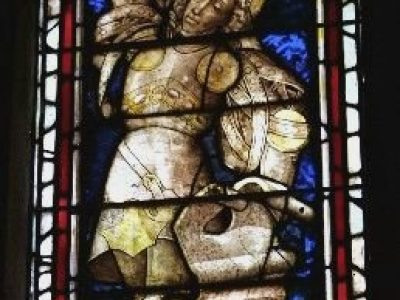
Cloisters, stained glass
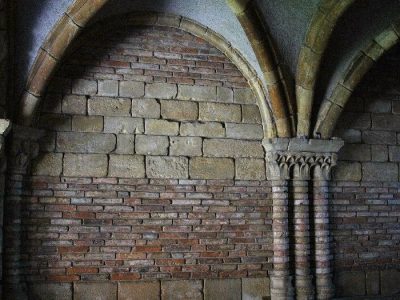
Cloisters, vaulting
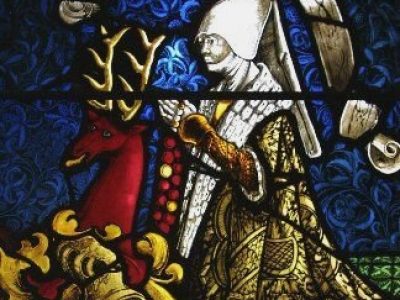
Cloister’s, stained glass
After The Cloisters, I walked around Fort Tryon Park and the Heather Gardens. It was a lovely, mostly sunny, Fall day. Thereafter, I took the A-train back to Columbus Circle (the 59th Street stop) and walked north up Broadway, past Lincoln Center to the Barnes & Nobel close-by, where I purchased Jose Saramago’s “Blindness” and had a bagel and soda at the Café, while looking over “Where (New York)” magazine for things to do in NYC.
It was dusk by the time I left to walk to the Natural History Museum at 81st and Central Park West. I want to see Hayden Planetarium, basically a huge, white sphere (maybe 80 feet in diameter) enclosed in a larger glass cube and nicely lit . . . the time to be there is dusk or after dark. What a beautiful structure! I took many pictures both exterior and interior, which I have high hopes came out despite the rather dark conditions. I saw the space show in the planetarium, which was $9 in addition to the museum’s usual $10 admission fee.
It was the depiction of simulated travel from earth to the far reaches of the Universe. More accurately, it was a stepping back in scale, in successive stages—the Earth, the Solar System, local stars and nebulae, the Milky Way galaxy, the local group (of galaxies), the local supercluster (of thousands of galaxies), and the whole of the known (observable) Universe. Nicely done! What I most appreciated was that the simulated travel views were based on actual astronomical data . . . I could imagine, if one could travel the path of our simulated journey, one would see something like what we saw. The program’s audio was also most impressive, the whole room (or at least my seat) shaking with the deep base notes. After the show, we were left to walk down the spiral walkway showcasing a timeline of the Universe, from Big Bang to current day. Also, there was a show in a special viewing chamber, simulating the formation of the Universe from then to now.
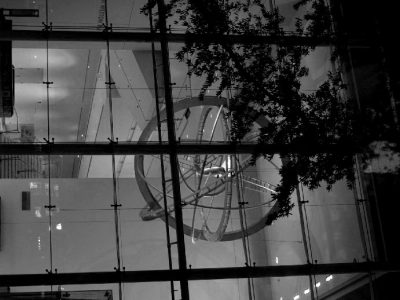
Stylized model of an atom?
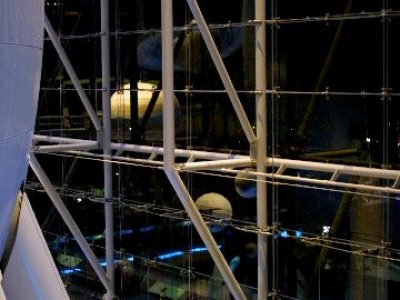
Rose Center curtain wall
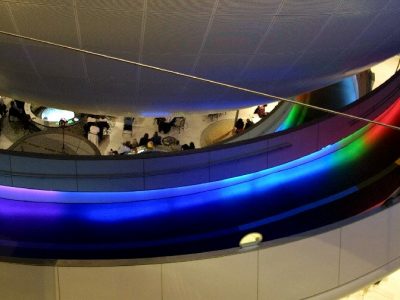
Rose Center–Hayden Planetarium
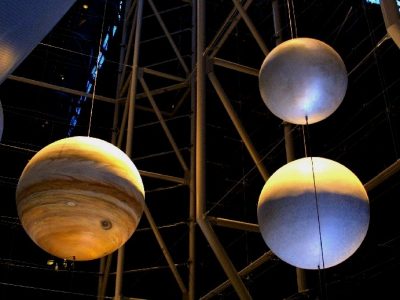
Rose Center, planetary detail
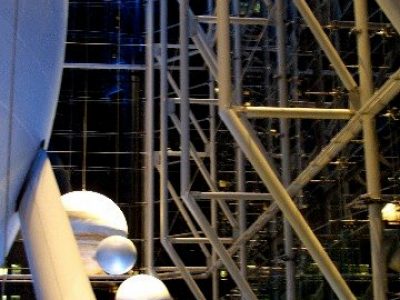
Solar System model
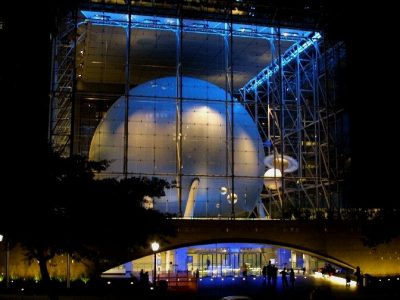
Rose Center–Hayden Planetarium
Saturday, October 20, 2001; 4:47PM
My experiences on my last day in NYC: I checked out and left my bags at the desk, walking across Central Park and northward, making my way toward the Guggenheim. It was Saturday, with all manner of people out in the park, moving in all manner of human-powered conveyance: running, walking with friends or dogs, bike-riding, including recumbent and armed powered, bike-like travel by those able-bodied and those not, wheel-chairing, in-line skating, skate-boarding, scootering, runners pushing jogger’s strollers.
I sat for a while on a bench at a pond, watching radio-controlled sailboats, their skippers and passersby.

Central Park trees with vendor’s stand
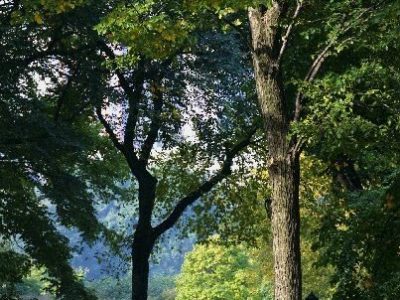
Central Park trees
I made it to the Guggenheim to find it dark inside–it’d been painted black and the skylight covered for the current exhibition (the Body & Soul of Brazil). Being as it was too dark to get pictures in appreciation of the building (I’m uncertain that, even with light, there’d be good angles), I left, not paying to enter the exhibit. I walked east across Madison and Park Avenues and turned south, walking down Lexington Avenue to the subway station to get a train taking me down to Greenwich Village. Down somewhere near 14th Street station, just after I’d jumped over from the express to the local, we stopped after barely starting, with the conductor announcing we were holding for an emergency . . . I couldn’t hear the nature of the emergency . . . the woman sitting next to me a couple of feet forward on the bench seat asked what’d he’d said. Another woman was impatient at the door, pounding it moderately once or twice, wanting to be let out and muttering several times, “I don’t believe this.” I said to her, “you’d think they could at least open the doors,” and went on reading “Blindness” by Saramago.
A few minutes later, the woman on the bench seat forward struck up conversation, seeing my bag, asking if I was a photographer, showing me her camera bag. She also was heading down to Greenwich Village (to see an exhibit . . . Andy Warhol, I believe). She was friendly, attractive . . . I gave her my card. I’d not mind meeting her again someday. Btw, she was on the 78th floor of the North Tower on September 11.
Once down in The Village, I walked through Washington Square, seeing a wide range of people. Toward the center of the Square there was a pro-hemp demonstration. Passing out of the park, someone at one of the chess tables wanted to hustle me, having just fleeced a cursing, heavyset, black guy. I continued strolling a block or two west, stopping a playground, full court game (at some points, not purely basketball, what with the amount of fouling and wrestling going on). Would-be players waited around the edge of the court for their turn to play . . . some shooting at the south basket when the full court game was up north. Spectators lined the fence surrounding the court.
I liked the feeling on the court among the players. One guy in particular caught my eye, as he was taking his shots at the south basket. He was slender, tallish, hair braided, and good, hitting shots with some confidence and style, but, most of all, he was smiling, good-natured, a playful goodwill ambassador. At one point, he consoled a disgruntled player on the sidelines who was loudly aggrieved by an opponent’s on-court etiquette. He knew the score. Ah, life!
For another of my N.Y.C. visits, see New York City Evening.
For some excellent black and white pictures of New York City by my good friend, Gordon Strauss, see “Gordon’s Tahlequah NYC page.”
I welcome any questions or comments.
To contact me (Keith Stanley), please email me at kesta1001@yahoo.com.
Here are some links to others of my pages: